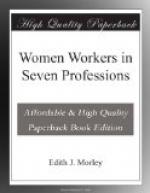There is ample room for a much larger body of trained midwives than exists at present, if the health and welfare of the nation are to be secured, while the women themselves could, under these conditions, earn a sufficient livelihood.
Trained nurses also specialise in midwifery. They take the full course of training described above, completing this by passing the Central Midwives’ Board Examination. They do not practise for themselves, but work only under doctors, thus replacing the monthly nurse. The improvement in health and comfort of both mother and child, when nursed by some one thoroughly competent, is very marked.
The fees which they receive for this work are usually 12 to 14 guineas for the month, and in some cases may rise to 18 guineas.
XIII
MASSAGE
This work demands a healthy body and cheerful mind, a love of the work, endurance, and much tact in dealing with the nervous cases for which this form of treatment is found to be beneficial.
It may be undertaken either
(1) As a separate profession, or
(2) As an additional qualification by trained nurses.
The training must be good and adequate to ensure any success as a masseuse, so great care should be exercised in the choice of a school. The many training schools advertised are of varying degrees of efficiency, and those prepared to train in a few weeks, or by correspondence only, are obviously unsatisfactory.
On application to the secretary of the Incorporated Society of Trained Masseuses, information can be obtained with regard to the training schools in London and the Provinces where a course of instruction in massage is given, which is accepted by the society as adequate.
The society itself is an independent examining body which insists on a satisfactory standard for massage workers. It holds two examinations yearly and grants a certificate to successful candidates. No one may enter for the examination unless she can show that she has received her training at one of the schools approved by the society.
Adequate training in massage includes a course of not less than six months in Elementary Anatomy and Physiology, the Theory and Practice of Massage and a course of bandaging. Students usually attend the classes from 10 A.M. to 4 P.M., lectures being given in the morning, demonstrations and practical work on “model patients” in the afternoon hours.
Sufficiently advanced students are allowed to attend at hospitals or infirmaries to see—and themselves to carry out under the teacher’s supervision—the treatment ordered for the patients by the doctor. In this way all students have opportunity during their training of seeing and giving treatment to the various cases which they may have to deal with as qualified masseuses when working under private doctors.
Some training schools give their own certificate after training, and this is useful as a guarantee of the training taken. It is not, however, such an assurance of efficiency to the medical profession or the general public as the certificate gained after examination by an independent examining body.




